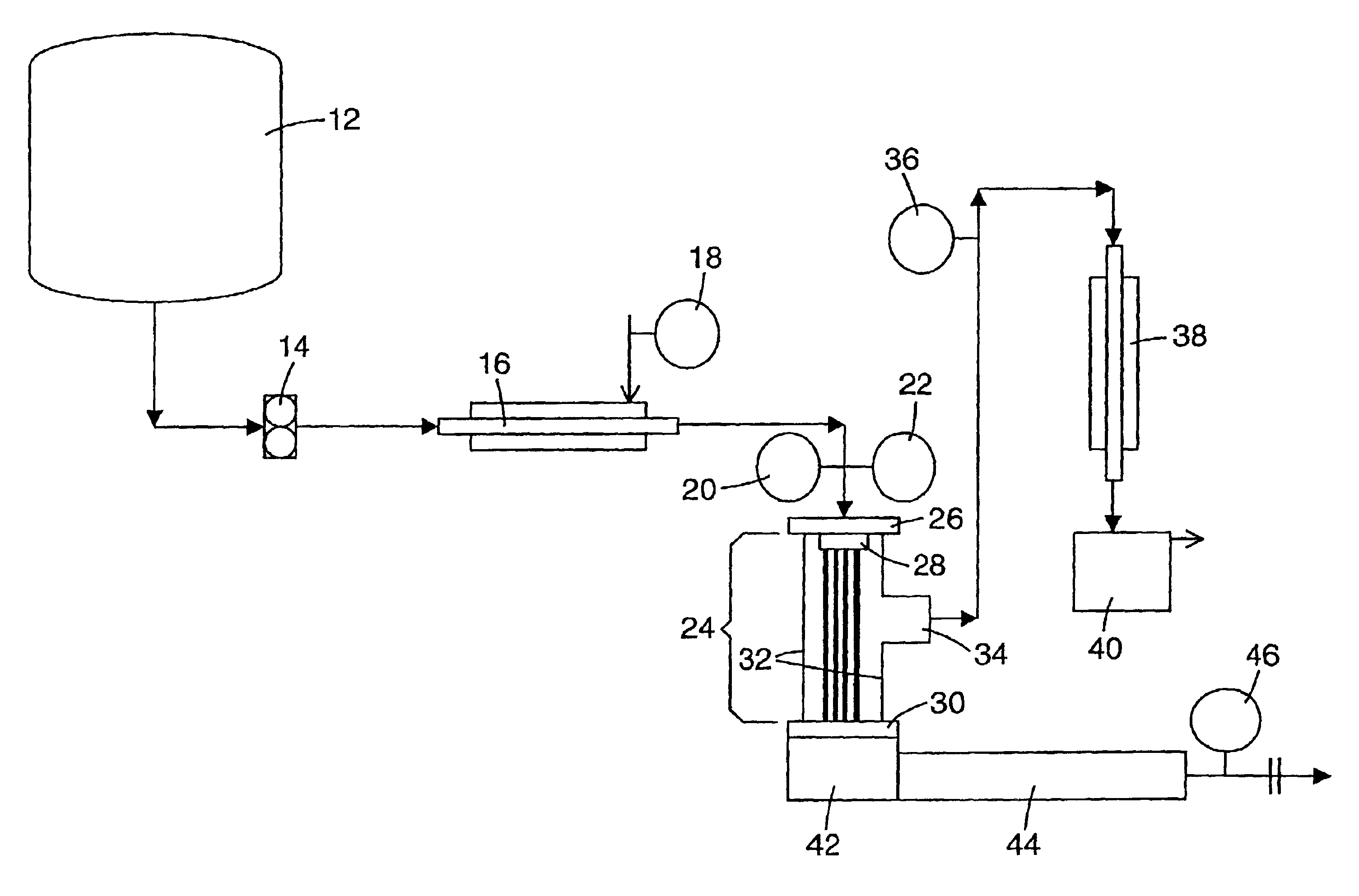Continuous process for controlled concentration of colloidal solutions
a colloidal solution and continuous process technology, applied in the direction of multiple-effect evaporation, separation processes, lighting and heating apparatus, etc., can solve the problems of colloidal solution decomposition, colloidal solution over-evaporation, colloidal solution degradation, etc., and achieve the effect of adjusting the vaporization rate quite quickly
- Summary
- Abstract
- Description
- Claims
- Application Information
AI Technical Summary
Benefits of technology
Problems solved by technology
Method used
Image
Examples
example 1
A ceramic colloid was prepared by addition of 163 g of boehmite (DISPERSAL™ 20 from Sasol GmbH, Hamburg, Germany) to a solution of 7.2 g of 70% nitric acid in 336 g of deionized water, followed by addition of 75 g methanol. This material was then processed according to Process A. The material was continuously fed through the heat exchanger (but with no heating), through the die and into the evaporation zone at one set of conditions. The product was then removed from the collection vessel. The pressure in the evaporation zone was then readjusted to produce products of different concentrations. For each set of conditions, samples of product were taken and analyzed for percent dried solids. The results are shown in Table 1.
TABLE 1InletEvaporationOutlet Concen-ConcentrationFeedZonetration (%(% DriedTemperaturePressureDried SolidsSampleSolids by wt.)(C.)(kPa)by wt.)128.23232.829.51228.23232.829.09328.23215.228.43428.23225.328.30528.23228.028.26
As seen, the outp...
example 2
Food Hydrocolloid
A food colloid was prepared by mixing 25.8 g corn starch (ARGO CORN STARCH™ from Best Foods, Englewood Cliffs, N.J.), 42.8 g granulated sugar (CRYSTAL SUGAR GRANULATED SUGAR™ from United Sugars Corp., Minneapolis, Minn.), and 435.8 g distilled water. This mixture was heated at atmospheric pressure with constant stirring to 95° C. to cause it to begin to increase in viscosity. The material was then cooled to room temperature. This material then processed according to Process A. The material was continuously fed through the heat exchanger, through the die and into the evaporation zone at one set of conditions of temperature and pressure. The product was then removed from the collection zone or vessel. The temperature in the heating zone and the pressure in the evaporation zone were then readjusted to produce products of different concentrations. For each set of conditions, samples of product were taken and analyzed for percent dried solids. The result are shown in Tab...
example 3
Organic-Inorganic Hydrocolloid
A colloid was prepared by mixing 50.1 g corn starch (ARGO CORN STARCH™), 225.4 g baking soda (ARM & HAMMER PURE BAKING SODA™ from Arm and Hammer Div. of Church & Dwight Co., Princeton, N.J.), and 224.7 g distilled water. This mixture was heated at atmospheric pressure with constant stirring to 70° C. to cause it to begin to bubble vigorously. The material was then cooled to 60° C. and stirred until the viscosity began to increase. The material was then cooled to room temperature. This material was then processed according to Process A. The material was continuously fed through the heat exchanger, through the die and into the evaporation zone at one set of conditions of temperature and pressure. The product was then removed from the collection zone. The temperature in the heating zone and the pressure in the evaporation zone were then readjusted to produce products of different concentrations. For each set of conditions, samples of product were taken and...
PUM
 Login to View More
Login to View More Abstract
Description
Claims
Application Information
 Login to View More
Login to View More - R&D
- Intellectual Property
- Life Sciences
- Materials
- Tech Scout
- Unparalleled Data Quality
- Higher Quality Content
- 60% Fewer Hallucinations
Browse by: Latest US Patents, China's latest patents, Technical Efficacy Thesaurus, Application Domain, Technology Topic, Popular Technical Reports.
© 2025 PatSnap. All rights reserved.Legal|Privacy policy|Modern Slavery Act Transparency Statement|Sitemap|About US| Contact US: help@patsnap.com



